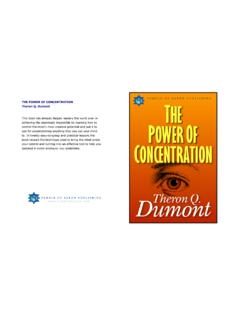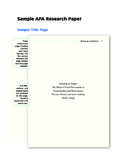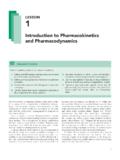Transcription of The Beginner's Guide to Representative Concentration …
1 The Beginner s Guide to Representative ConcentrationPathwaysG. P. WAYNE Page | 1 The Beginner s Guide to Representative Concentration Pathways By Graham Wayne Version , August 2013 Introduction Many factors have to be taken into account when trying to predict how future global warming will contribute to climate change. The amount of future greenhouse gas emissions is a key variable. Developments in technology, changes in energy generation and land use, global and regional economic circumstances and population growth must also be considered.
2 So that research between different groups is complementary and comparable, a standard set of scenarios are used to ensure that starting conditions, historical data and projections are employed consistently across the various branches of climate science. The Intergovernmental Panel on Climate Change ( IPCC ) Fifth Assessment Report (AR5) is due for publication in 2013- 14. Its findings will be based on a new set of scenarios that replace the Special Report on Emissions Scenarios (SRES) standards employed in two previous reports.
3 The new scenarios are called Representative Concentration Pathways ( RCPs). There are four pathways: , RCP6, and - the last is also referred to as RCP3- PD. (The numbers refer to forcings for each RCP; PD stands for Peak and Decline). The name Representative Concentration pathways was chosen to emphasize the rationale behind their use. RCPs are referred to as pathways in order to emphasize that their primary purpose is to provide time-dependent projections of atmospheric greenhouse gas (GHG) concentrations .
4 In addition, the term pathway is meant to emphasize that it is not only a specific long-term Concentration or radiative forcing outcome, such as a stabilization level, that is of interest, but also the trajectory that is taken over time to reach that outcome. They are Representative in that they are one of several different scenarios that have similar radiative forcing and emissions characteristics . (IPCC Expert Meeting Report, Towards New Scenarios For Analysis Of Emissions, Climate Change, Impacts, And Response Strategies, IPCC 2007) This Guide to Representative Concentration Pathways assumes no prior knowledge.
5 In Part 1 we explore their historical background, explain why scenarios are necessary, and who uses them. Readers already familiar with the background may wish to skip this section. Part 2 starts with an examination of the demand for new scenarios, and why they were deemed necessary. The aims and requirements of stakeholders are described, how the development teams were selected, and the process by which the RCPs were created, checked and validated. In Part 3 we take a look at the scenarios in detail, consider the technical aspects, the differences between the four RCPs, and how they compare to earlier SRES scenarios.
6 Page | 2 Table of Contents Part 1: An introduction to scenarios .. 3 Why are scenarios necessary? .. 3 Who uses climate scenarios? .. 4 What do RCPs Consist Of ? .. 5 Part 2: Creating new scenarios .. 7 Design 8 Working with the Stakeholders .. 8 Improvements over SRES .. 9 Development Aims and Products .. 11 Beyond 2100 - Extended Concentration Pathways (ECP) .. 12 Part 3: RCP technical summary .. 13 An important note about socio-economic data .. 13 RCP Primary Characteristics .. 14 RCP Information, Data Types and Resolutions.
7 14 Emissions and concentrations , forcings and temperature anomalies (table) .. 15 Radiative Forcings .. 15 RCP Emission Trajectories .. 16 Greenhouse Gas concentrations .. 16 Atmospheric Air Pollutants .. 17 Radiative Forcing Trends .. 18 Population and GDP .. 18 Energy and oil consumption .. 19 Energy sources at years 2000 and 2100 .. 19 Land Use .. 20 Comparisons with SRES equivalents .. 21 Extended Concentration pathway Emissions and Forcing .. 21 Further Reading .. 22 Page | 3 Part 1: An introduction to scenarios Why are scenarios necessary?
8 Scenarios of different rates and magnitudes of climate change provide a basis for assessing the risk of crossing identifiable thresholds in both physical change and impacts on biological and human systems . Source: Towards New Scenarios for Analysis of Emissions, Climate Change, Impacts, and Response Strategies , IPCC Technical Summary, 2007 There are many climate modelling teams around the world. If they all used different metrics, made different assumptions about baselines and starting points, then it would be very difficult to compare one study to another.
9 In the same way, models could not be validated against other different, independent models, and communication between climate modelling groups would be made more complex and time-consuming. Another problem is the cost of running models. The powerful computers required are in short supply and great demand. Simulation programming that had to start from scratch for each experiment would be wholly impractical. Scenarios provide a framework by which the process of building experiments can be streamlined. In order to address these issues, in 1992 the Intergovernmental Panel on Climate Change ( IPCC) published the first set of climate change scenarios, called IS92.
10 In year 2000 the IPCC released a second generation of projections, collectively referred to as the Special Report on Emissions Scenarios ( SRES). These were used in two subsequent reports; the Third Assessment Report (TAR) and Assessment Report Four (AR4) and have provided common reference points for a great deal of climate science research in the last decade. In 2007, the IPCC responded to calls for improvements to SRES by catalysing the process that produced the Representative Concentration Pathways (RCPs).







